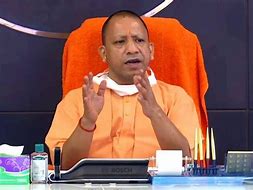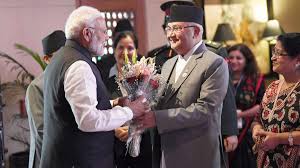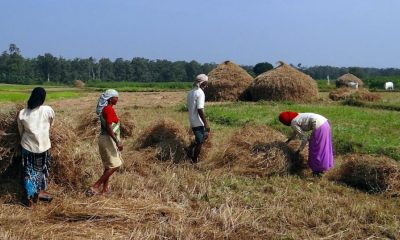Feature
As agriculture turns uneconomic, farmers turn daily-wagers for survival

Ram Avatar and Kota Ramadevi are farmers in the agrarian country that is India, living thousands of kilometres away from each other but there is a common factor that binds them. Both are struggling to earn their daily bread and butter despite owning agricultural land.
Ram Avatar, a tribal, has been growing maize and rice on one acre of land he owns in Pacha Tola village of Uttar Pradesh’s Mirzapur. However, farming has turned negative for him as he found the input costs on cultivation higher than the remuneration.
“Earlier, we could save some money by selling a part of the grains we grew. However, the expenditure on seeds, fertilisers and pesticides has gone up substantially while the returns have reduced due to the fall in crop prices,” Ram Avtar told IANS.
This has forced Ram Avatar and many other such small farmers in his village to become labourers to make ends meet.

Ramadevi, a widow from Telangana, owns three acres of fertile land in Narlapur village of Warangal district, which is quite suitable for cultivating the cotton cash-crop. However, she prefers taking up menial jobs in the nearby urban areas as sheer thought of farming gives her the jitters. Her husband committed suicide two years ago after failing to repay his farm loan.
“My husband sold one acre to repay a part of the debt. However, he had to take a new loan after cotton prices again fell the next year. He killed himself out of frustration,” she recounted.
The country has seen several farm agitations this year over falling crop prices even as retail prices remained high.
Farmers have been demanding better remuneration that is fixed using ‘C2’ formula, recommended by Swaminathan Commission, which is a comprehensive cost that takes care of rental value of owned land, rent paid for leased-in land and imputed value of family labour.
Amidst the protests, the BJP-government at the centre revised the MSP for 23 commodities using the ‘A2+FL’ formula, which increased the prices but was not at par with the farmers’ expectations.

As the government agencies did not open adequate numbers of procurement centres and that too in the prescribed time, the whole purpose of the MSP has been lost, said Harpal Singh, president of Bhartiya Kisan Union (Asli).
“Farmers do not have proper storage facilities. So, when procurement centres were not operationalised in time, they had to sell at the quite low rates decided by traders,” Singh said.
He said the price received by farmers in the open market for jowar (sorghum) was around Rs 1,000 per quintal when the MSP was Rs 2,450. Similarly, bajra (pearl millet) could fetch just Rs 1,000-1,200 per quintal and makka (maize) could get Rs 1,000 when the MSP were fixed at Rs 1,950 and Rs 1,700, respectively.
“Many of these farmers are in distress now. They travel to nearby cities everyday to work as labourers for Rs 200-300 a day,” Singh said.
A few days ago, onion prices received by farmers slumped to just Rs 1-2 per kg when the retails prices were over Rs 20.
Parliamentarian and farmers’ leader Raju Shetti, who has introduced two Private Member’s Bills in the Lok Sabha for a farm loan waiver and the MSP based on ‘C2’ formula, said the government lacked in planning and the will to take action.
“There is a lack of political will besides bureaucratic apathy. In case of onions, the government allowed imports from Pakistan despite knowing that domestic supply was optimum,” Shetti told .
“The situation is more or less similar for other agricultural commodities. It has led to confusion and tension in farmers,” he added.

According to the National Sample Survey of India (NSSO), the average monthly income per agricultural household in 2012-13 was estimated as Rs 6,426 against expenditure of Rs 6,223.
Farm revenues have declined for a number of crops despite increasing production, the Economic Survey 2018 tabled in Parliament earlier this year, stated.
Agriculture expert Devinder Sharma held the wrong policies of the government responsible for the poor financial situation of the farmers.
“The government neither has control over the market nor has a mechanism to deal with the surplus,” he said.
“If the government can waive corporate loans worth Rs 3.5 lakh crore, why cannot it shell out just Rs 100 crore to procure agriculture commodities? Farmers put in hard work and all resources they have. If prices crash, their livelihood too is crashes.”
Sharma said the government can use the additionally procured commodities and distribute it among the hungry.
“How difficult is this in a country where 20 crore (200 million) people go to sleep without food,” he asked.
The Economic Survey also said the impact of climate change could reduce annual agricultural incomes by 15 to 25 per cent, which translates into loss of over Rs 3,600 for the median farm household.
It said the susceptibility to climate change can be minimised by extending irrigation facilities and replacing untargeted subsidies in power and fertiliser by direct income support.
However, about 73.2 million hectares area of 141.4 million hectares net sown area (52 per cent) is still unirrigated and rainfed — making Indian agriculture vulnerable to the vagaries of the weather.
Entertainment
Meghalaya Reserves Legalized Gambling and Sports Betting for Tourists

The State Scores Extra High on Gaming-Friendly Industry Index
Meghalaya scored 92.85 out of 100 possible points in a Gaming Industry Index and proved to be India’s most gaming-friendly state following its recent profound legislation changes over the field allowing land-based and online gaming, including games of chance, under a licensing regime.
The index by the UK India Business Council (UKIBC) uses a scale of 0 to 100 to measure the level of legalisation on gambling and betting achieved by a state based on the scores over a set of seven different games – lottery, horse racing, betting on sports, poker, rummy, casino and fantasy sports
Starting from February last year, Meghalaya became the third state in India’s northeast to legalise gambling and betting after Sikkim and Nagaland. After consultations with the UKIBC, the state proceeded with the adoption of the Meghalaya Regulation of Gaming Act, 2021 and the nullification of the Meghalaya Prevention of Gambling Act, 1970. Subsequently in December, the Meghalaya Regulation of Gaming Rules, 2021 were notified and came into force.
All for the Tourists
The move to legalise and license various forms of offline and online betting and gambling in Meghalaya is aimed at boosting tourism and creating jobs, and altogether raising taxation revenues for the northeastern state. At the same time, the opportunities to bet and gamble legally will be reserved only for tourists and visitors.
“We came out with a Gaming Act and subsequently framed the Regulation of Gaming Rules, 2021. The government will accordingly issue licenses to operate games of skill and chance, both online and offline,” said James P. K. Sangma, Meghalaya State Law and Taxation Minister speaking in the capital city of Shillong. “But the legalized gambling and gaming will only be for tourists and not residents of Meghalaya,” he continued.
To be allowed to play, tourists and people visiting the state for work or business purposes will have to prove their non-resident status by presenting appropriate documents, in a process similar to a bank KYC (Know Your Customer) procedure.
Meghalaya Reaches Out to a Vast Market
With 140 millions of people in India estimated to bet regularly on sports, and a total of 370 million desi bettors around prominent sporting events, as per data from one of the latest reports by Esse N Videri, Meghalaya is set to reach out and take a piece of a vast market.
Estimates on the financial value of India’s sports betting market, combined across all types of offline channels and online sports and cricket predictions and betting platforms, speak about amounts between $130 and $150 billion (roughly between ₹9.7 and ₹11.5 lakh crore).
Andhra Pradesh, Telangana and Delhi are shown to deliver the highest number of bettors and Meghalaya can count on substantial tourists flow from their betting circles. The sports betting communities of Karnataka, Maharashtra, Uttar Pradesh and Haryana are also not to be underestimated.
Among the sports, cricket is most popular, registering 68 percent of the total bet count analyzed by Esse N Videri. Football takes second position with 11 percent of the bets, followed by betting on FIFA at 7 percent and on eCricket at 5 percent. The last position in the Top 5 of popular sports for betting in India is taken by tennis with 3 percent of the bet count.
Local Citizens will Still have Their Teer Betting
Meghalaya residents will still be permitted to participate in teer betting over arrow-shooting results. Teer is a traditional method of gambling, somewhat similar to a lottery draw, and held under the rules of the Meghalaya Regulation of the Game of Arrow Shooting and the Sale of Teer Tickets Act, 2018.
Teer includes bettors wagering on the number of arrows that reach the target which is placed about 50 meters away from a team of 20 archers positioned in a semicircle.
The archers shoot volleys of arrows at the target for ten minutes, and players place their bets choosing a number between 0 and 99 trying to guess the last two digits of the number of arrows that successfully pierce the target.
If, for example, the number of hits is 256, anyone who has bet on 56 wins an amount eight times bigger than their wager.





















